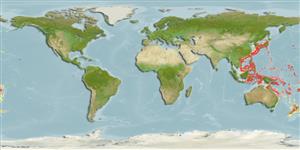Holocéphales (chimères) (chimaeras) >
Chimaeriformes (Chimaeras) >
Chimaeridae (Shortnose chimaeras or ratfishes)
Etymology: Chimaera: Named for the mythological creature composed of parts of multiple animals, referring to their odd mix of characteristics. (See ETYFish); phantasma: Greek for phantom or apparition, probably referring to its striking appearance in life (silvery, with jet-black bands down the sides) and/or overall ghoulish appearance common to all chimaeras. (See ETYFish).
More on authors: Jordan & Snyder.
Environment: milieu / climate zone / depth range / distribution range
Écologie
marin bathydémersal; profondeur 90 - 540 m (Ref. 9904). Deep-water
Western Pacific: Japan, Korea, China, Taiwan, and the Philippines.
Taille / Poids / Âge
Maturity: Lm ? range ? - ? cm
Max length : 100.0 cm TL mâle / non sexé; (Ref. 637); common length : 60.0 cm TL mâle / non sexé; (Ref. 9137)
Found in continental shelves and upper slopes (Ref. 9904, 11230); shelf edge, 60-550 m (Ref. 11230). Feeds mainly on small benthic animals (Ref. 637). Oviparous (Ref. 205). Eggs are encased in horny shells (Ref. 205). Used in Chinese medicine (Ref. 12166). Caught with bottom trawls but utilization uncertain except as fish balls (kamaboko) in Japan (Ref. 9904).
Life cycle and mating behavior
Maturité | Reproduction | Frai | Œufs | Fécondité | Larves
De la Paz, R.M. and R. Interior, 1979. Deep-sea fishes off Lubang Island, Philippines. Nat. Applied Sci. Bull. 31(3-4):175 p. (Ref. 5282)
Statut dans la liste rouge de l'IUCN (Ref. 130435)
Menace pour l'homme
Harmless
Utilisations par l'homme
Pêcheries: commercial
Plus d'informations
RéférencesAquacultureProfil d'aquacultureSouchesGénétiqueElectrophoresesHéritabilitéPathologiesTraitementNutrientsMass conversion
CollaborateursImagesStamps, Coins Misc.SonsCiguateraVitesseType de nageSurface branchialeOtolithesCerveauxVision
Outils
Articles particuliers
Télécharger en XML
Sources Internet
Estimates based on models
Preferred temperature (Ref.
123201): 8.4 - 21.7, mean 15.9 °C (based on 203 cells).
Phylogenetic diversity index (Ref.
82804): PD
50 = 0.5000 [Uniqueness, from 0.5 = low to 2.0 = high].
Bayesian length-weight: a=0.00282 (0.00118 - 0.00673), b=3.10 (2.89 - 3.31), in cm total length, based on LWR estimates for this (Sub)family-body shape (Ref.
93245).
Niveau trophique (Ref.
69278): 3.5 ±0.42 se; based on food items.
Résilience (Ref.
120179): Faible, temps minimum de doublement de population : 4,5 à 14 années (Assuming Fec <100).
Fishing Vulnerability (Ref.
59153): High vulnerability (60 of 100).
